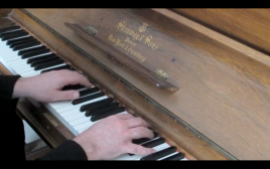
Many Italian Americans pronounce cucumber – “cetriolo” in the Italian dictionary – this way: ‘jadrool’.
In Fairport, New York, where I grew up, there were lots of Italian American families, and I had many Italian American friends (still do). I married an Italian American from Liverpool, New York, and have a son from this marriage who, though he is only *half* Italian American, regards himself as *almost completely* Italian American. I noticed the way my friends and my (then) in-laws and wife pronounced words for food dishes did not correspond (to my ear) to either the spelling or the pronunciations provided in my fat dictionary. Writer Dan Nosovitz of AtlasObsucra.com explains why, in How Capicola Became Gabagool: The Italian New Jersey Accent, Explained:
Let’s do a fun experiment and take three separate linguistic trends from southern Italian dialects and combine them all to show how one Standard Italian word can be so thoroughly mangled in the U.S.
First: “The features that you’ll find across a lot of these dialects, and one that you still hear a lot in southern Italy today, is vowels at the ends of words are pronounced very very softly, and usually as more of an ‘uh’ vowel,” says Olivo-Shaw. D’Imperio is a little more extreme, calling it “vowel deletion.” Basically: if the final syllable is a vowel? You can get rid of it. Vowel deletion is common amongst many languages, and is done for the same reason that, sometimes, vowels are added: to make the flow from one word to another more seamless. It’s easiest, in terms of muscle movement, to transition from a vowel to a consonant and vice versa. A vowel to a vowel is difficult; in English, that’s why we have “a” versus “an” in phrases like “a potato” or “an apple.” Some Italian words that would follow food words, like prepositions or articles, would start with a vowel, and it’s easier to just remove it so you don’t have to do the vowel-to-vowel transition.
The stereotypical Italian “It’s a-me, Mario!” addition of a vowel is done for the same reason: Italian is a very fluid, musical language, and Italian speakers will try to eliminate the awkwardness of going consonant-to-consonant. So they’ll just add in a generic vowel sound—”ah” or “uh”—between consonants, to make it flow better.
Second: “A lot of the ‘o’ sounds will be, as we call it in linguistics, raised, so it’ll be pronounced more like ‘ooh’,” says Olivo-Shaw. Got it: O=Ooh.
And third: “A lot of what we call the voiceless consonants, like a ‘k’ sound, will be pronounced as a voiced consonant,” says Olivo-Shaw. This is a tricky one to explain, but basically the difference between a voiced and a voiceless consonant can be felt if you place your fingers over your Adam’s apple and say as short of a sound with that consonant as you can. A voiced consonant will cause a vibration, and voiceless will not. So like, when you try to just make a “g” sound, it’ll come out as “guh.” But a “k” sound can be made without using your vocal cords at all, preventing a vibration. So “k” would be voiceless, and “g” would be voiced. Try it! It’s fun.
Okay so, we’ve got three linguistic quirks common to most of the southern Italian ancient languages. Now try to pronounce “capicola.”
The “c” sounds, which are really “k” sounds, become voiced, so they turn into “g”. Do the same with the “p”; that’s a voiceless consonant, and we want voiced ones, so change that to a “b”. The second-to-last vowel, an “oh” sound, gets raised, so change that to an “ooh.” And toss out the last syllable. It’s just a vowel, who needs it? Now try again.
Yeah. Gabagool.
My Central New York State friends and family didn’t share the famously distinctive accents of their New Jersey brethren, but they did pronounce “Prosciutto” like this: “pruh-zhoot” (or “bruh-zhoot,” beginning with the voiced consonant).
—
P.S. – A “jadrool,” you should know, can mean moron as well as “cucumber.”
h/t BD




